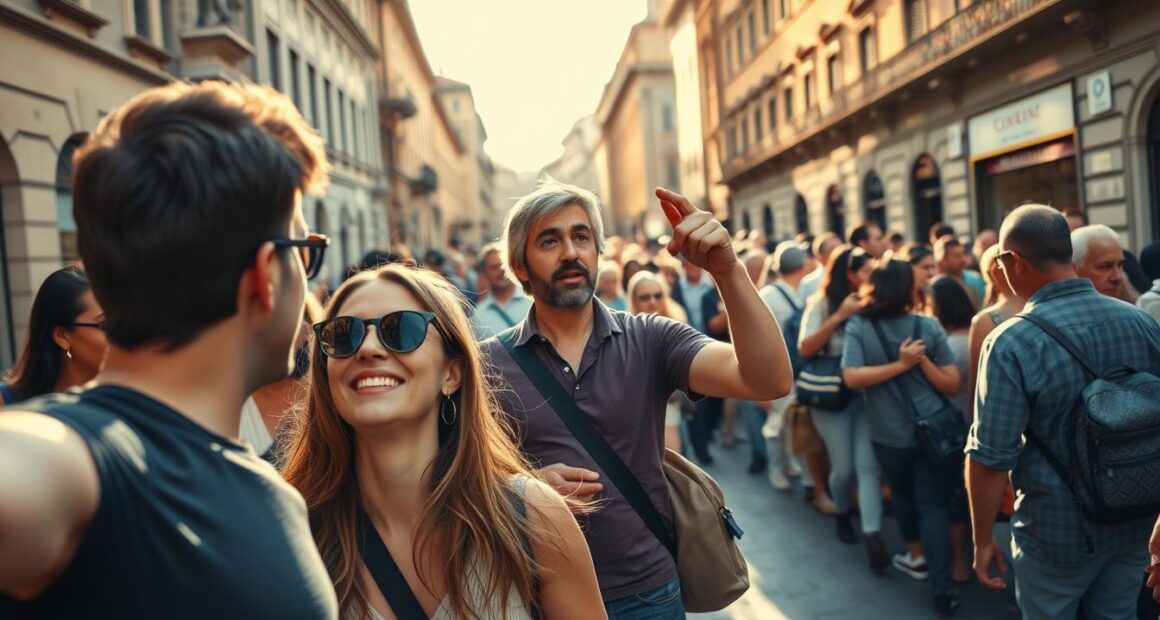Did you know that approximately 76% of US tourists report experiencing culture shock while traveling in Italy? This statistic highlights just how crucial it is to be aware of certain cultural nuances and travel tips for Italy to enhance your experience. Whether you’re strolling through the picturesque streets of Florence or indulging in authentic Roman cuisine, avoiding these common blunders in Italy can make your journey even more enjoyable. In this article, you will discover the top mistakes US tourists make in Italy and how to sidestep them for a smoother adventure through this enchanting country.
Key Takeaways
- Understand tipping norms, as they differ greatly from the US.
- Always carry cash, as some establishments may not accept cards.
- Purchase tickets in advance for public transportation to avoid fines.
- Be mindful of local customs, especially in markets and cafes.
- Plan your itinerary wisely, but leave room for spontaneity.
Understanding Italian Tipping Culture
When you travel to Italy, understanding the nuances of Italian tipping culture becomes essential for a pleasant experience. Unlike in the United States, where tipping is a significant part of service workers’ income, many Italians receive a fair wage that reduces the reliance on tips. In Italy, a service charge is often included in your bill, which alters the expectations around tipping etiquette in Italy.
Why Tipping is Different in Italy
In Italy, tipping is more about showing appreciation rather than fulfilling a financial obligation. Waitstaff and other service industry workers often make a reasonable salary, making it less critical for patrons to tip generously. Rounding up to the nearest euro serves as a standard gesture of goodwill. For exceptional service, leaving a small tip signals gratitude and positively reflects your experience.
When to Leave a Tip, If at All
So, when to tip in Italy? Generally, you should consider tipping in casual dining situations, bars, or when receiving personal service. Here’s a quick guide:
| Situation | Tip Amount |
|---|---|
| Full-service restaurants | Round up the bill or leave €1-€2 for good service |
| Cafés and bars | Leave loose change or round up |
| Taxi drivers | Rounding up the fare is appreciated |
| Hotel staff | €1-€2 for bellhops, leave at your discretion for housekeepers |

Understanding when and how much to tip in Italy enhances your travel experience and encourages positive interactions with locals. Embrace the local customs surrounding tipping etiquette in Italy, and you will likely leave a lasting impression on those who serve you. Enjoy your time in this beautiful country!
The Importance of Cash in Italy
When traveling through Italy, understanding the significance of cash can greatly enhance your experience. Many tourists find that cash is often the preferred method of payment, especially for minor purchases. This practice is deeply rooted in the local culture, which values traditional methods of cash use in Italy.
Why Cash is King in Italy
Cash reigns supreme for various reasons. Primarily, many small businesses like cafés, markets, and street vendors do not accept credit cards. The use of cash ensures quick transactions, allowing you to enjoy a seamless shopping experience. Furthermore, locals appreciate when you pay with smaller bills. Using larger denominations might cause hesitation from vendors and can even lead to less favorable service.
Where Cards Often Aren’t Accepted
Despite the growing popularity of digital transactions, cash remains a necessity in many settings. Several establishments in Italy do not accept credit cards, particularly for purchases under €10. Here are some places where you might struggle with using credit cards:
- Local food markets
- Street food vendors
- Small cafes
- Public restrooms
Having sufficient cash on hand ensures you can navigate these situations without hassle. It’s advisable to familiarize yourself with various payment methods in Italy. This preparation can save you from potential disappointments when enjoying local cuisine or shopping.
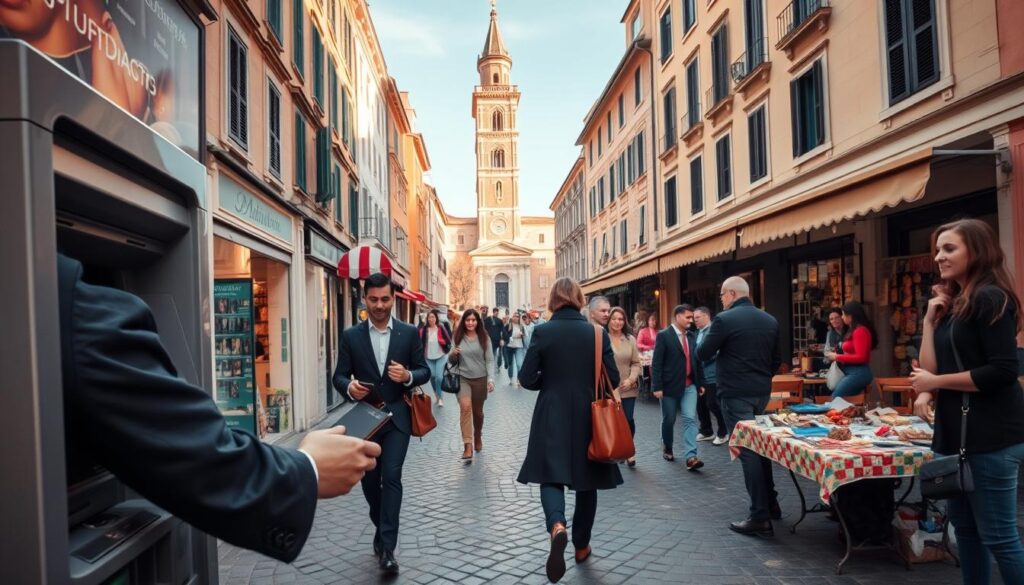
| Payment Method | Common Uses | Acceptance Rate |
|---|---|---|
| Cash | Street vendors, Small cafes, Markets | High |
| Credit Cards | Hotels, Larger restaurants, Shops | Moderate |
| Mobile Payments | Trendy cafes, Major cities | Low |
Buying Tickets Before Boarding Public Transport
Exploring Italy via public transport can be an enjoyable experience. Yet, one mistake many tourists make is boarding without first purchasing a ticket. Understanding proper ticket purchase tips is essential, as failing to do so may lead to fines. Learning the right steps can save you both time and money.
How to Avoid Fines from Ticket Inspection
To avoid fines in Italy, ensure that you purchase your ticket before boarding any bus, tram, or train. Inspectors frequently travel through public transport in Italy and check for valid tickets. If you are caught without one, the fines can be substantial. Always validate your ticket at the designated machines, as tickets need to be activated before use.
Tips for Purchasing Transport Tickets
Implementing ticket purchase tips can enhance your travel experience. Begin by locating nearby ticket machines, which are usually available at major stops. Consider buying multiple tickets at once, as they remain valid until validated. This approach helps you avoid last-minute scrambles and ensures easier access to transport when you’re on the move. Familiarize yourself with the various ticket options available, as different zones and types will affect pricing.
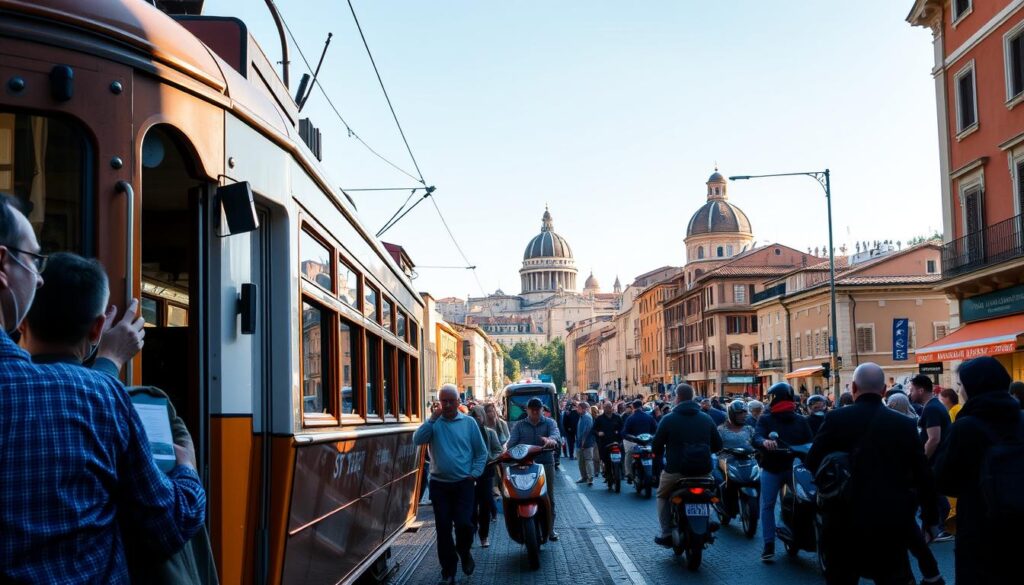
Top 10 Mistakes US Tourists Make in Italy
Traveling in Italy brings incredible experiences, but it’s easy to fall into common pitfalls. Many visitors overlook important aspects, leading to stress or missed opportunities. Here are some frequent mistakes to avoid while ensuring a memorable trip.
Overplanning Your Itinerary
One of the top mistakes in Italy involves overplanning your itinerary. While it’s tempting to cram numerous destinations into your schedule, this approach often results in exhaustion. Rushing from one place to another can diminish your ability to enjoy spontaneous adventures. Incorporate travel itinerary tips by allowing some flexibility for delays, relaxation, or simply enjoying a leisurely meal.
Not Checking Opening Hours for Attractions
Another frequent oversight is not verifying the opening hours of attractions. Many sites observe different hours on Sundays or public holidays. Failing to check these schedules can lead to wasted time standing outside closed doors. Planning ahead will enhance your overall experience, allowing you to prioritize your must-see destinations.
Ignoring Local Customs and Etiquette
A critical error is ignoring local customs and etiquette. Familiarizing yourself with understanding Italian customs enriches your interactions with locals. Simple gestures, like greeting with a smile or saying “buongiorno,” can create a positive atmosphere. Respecting traditions will help you blend seamlessly into the culture, enhancing your travel experience.
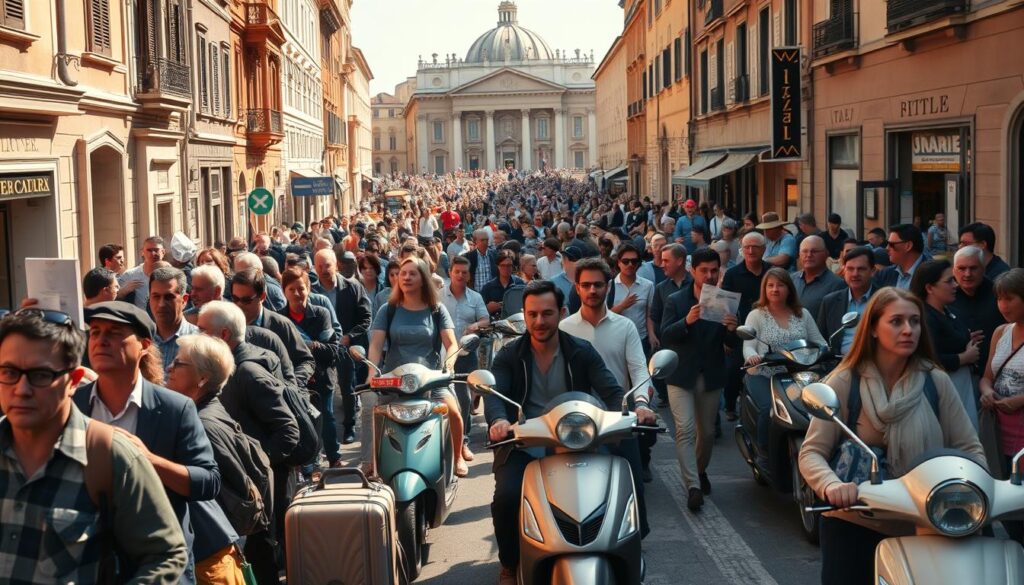
Standing When Drinking Coffee
The coffee culture in Italy is rich and unique, with customs that every traveler should embrace. One significant aspect is the traditional practice of ordering coffee while standing at the bar. This method not only immerses you in the local atmosphere but also offers notable savings compared to sitting down.
The Cost Differences Between Standing and Sitting
When it comes to standing versus sitting coffee pricing, the choice can impact your wallet significantly. Generally speaking, beverages consumed at the bar come without a service charge, making them more affordable. In contrast, ordering a coffee while seated tends to incur an additional fee. Familiarizing yourself with these cost differences could make each coffee break more budget-friendly.
How to Order Coffee Like a Local
Ordering coffee in Italy is an experience in itself. To blend in with locals, follow this straightforward process: first, pay at the cashier and receive your receipt. Next, approach the barista with your receipt in hand. Simple yet effective, this method ensures you enjoy the full richness of the Italian coffee experience while keeping your costs in check.
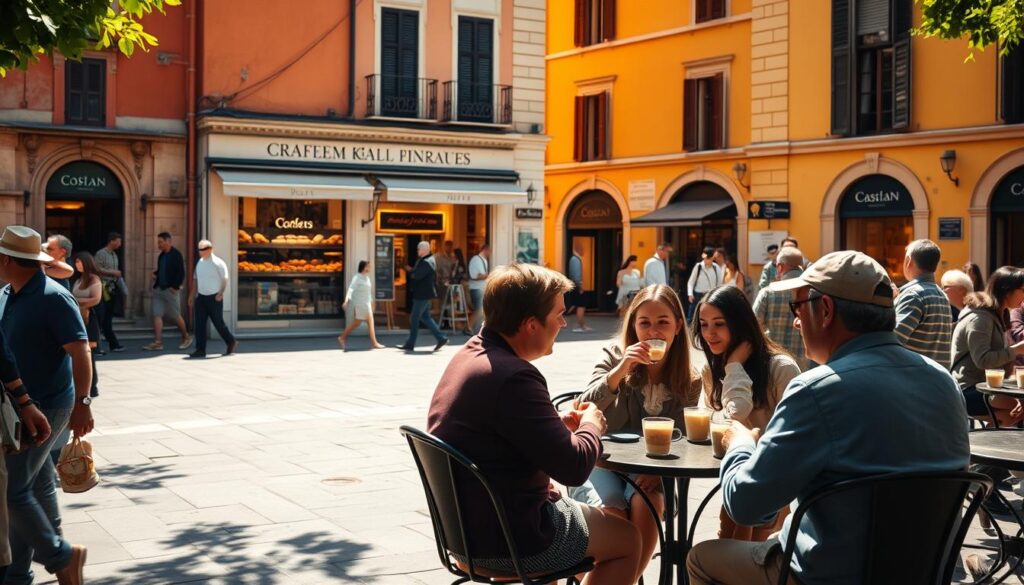
By understanding the nuances of coffee culture in Italy, you not only enhance your enjoyment but also optimize your spending. Whether you choose to sip your espresso standing or lounging at a table, each moment becomes part of a delightful Italian journey.
Be Wary of Free Gifts and Street Vendors
When exploring Italy, you might encounter numerous street vendors in Italy offering what appear to be free gifts. These seemingly generous gestures often come with hidden obligations. Vendors can be quite persistent, and it’s essential to approach these offers with free gifts caution. Understanding the realities behind these “free” offerings can help you navigate your experience more safely.
The Reality Behind ‘Free’ Offering
The allure of a free gift may entice you, but it’s common for vendors to provide such items with the expectation of payment for other goods or services. If you refuse, you may face pressure or aggressive tactics. It’s important to recognize this tactic to avoid any uncomfortable situations.
Legal Risks of Buying from Unlicensed Vendors
Purchasing items from street vendors posing legal risks should raise red flags. Often, these vendors operate without proper licenses, leading to potential fines for both parties involved. These legal issues with vendors highlight the importance of sticking to licensed shops. Your shopping experience will be safer, plus you support legitimate businesses.

Being Mindful in Open Air Markets
Exploring open-air markets in Italy can be one of the most enriching experiences during your trip. These markets are vibrant centers of local culture, offering a variety of fresh produce, artisanal goods, and unique experiences. Engaging with vendors and respecting their practices enhances your market shopping etiquette, ensuring a pleasant interaction.
Why You Shouldn’t Touch the Produce
In most open-air markets in Italy, touching the produce is frowned upon. Vendors prefer that you ask for assistance instead of handling the items yourself. This practice ensures the quality and integrity of the goods. When you respect this custom, you not only uphold local market etiquette but also foster better relationships with the vendors.
Respecting Local Market Customs
Each market has its own set of traditions, so pay attention to how other customers interact. Understanding market shopping etiquette includes greeting vendors, asking questions about the produce, and perhaps even trying out a sample before purchasing. Properly handling produce in Italy by letting vendors assist you displays respect for their work and the goods they provide.

How to Avoid Long Queues at Attractions
Visiting Italy means you will encounter stunning sites that often attract crowds. Planning ahead can help you avoid queues in Italy, allowing for a more enjoyable experience. Implementing ticket purchasing tips can save you valuable time and enhance your overall visit. Here are some strategies for enjoying these popular attractions without waiting in long lines.
The Benefits of Buying Tickets in Advance
Purchasing tickets online in advance offers numerous advantages. Not only does this help you avoid queues in Italy, but it also allows you to secure your entry for popular attractions, such as the Colosseum or the Uffizi Gallery. Many venues offer discounts for early purchases, creating additional savings. Imagine walking past groups of people waiting in line while you head straight to the entrance—this is a reality with advance bookings.
Alternative Ways to Experience Popular Sites
If you prefer a more relaxed approach, consider visiting attractions at off-peak times. Exploring lesser-known sites can also be rewarding, providing a chance to enjoy Italy’s rich history and culture without the hustle of large crowds. Early mornings or late afternoons are prime times to experience attractions without lines, ensuring a more intimate atmosphere. By embracing these options, your trip can become a blend of anticipated highlights and hidden gems.
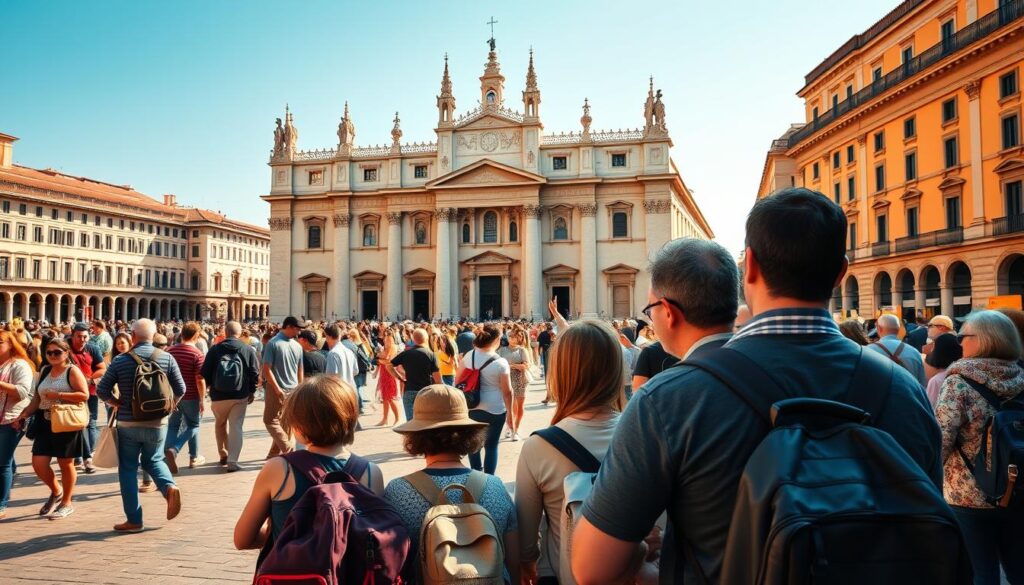
Conclusion
As you plan your Italian getaway, remember that awareness and understanding can greatly enhance your travel experience. By learning about tipping practices, the necessity of cash, and local customs, you can avoid common mistakes that many US tourists in Italy tend to make. These Italian travel tips will empower you to navigate the country with greater confidence and enjoyment.
Embracing the rich culture and beauty of Italy means adapting to its unique practices. The experiences you gain through this adjustment will create lasting memories and deeper connections with the locals and their way of life. Keeping in mind these common mistakes to avoid will help you savor every moment of your journey.
Traveling is not just about visiting new places; it’s about learning from them. By taking the time to be mindful of the cultural nuances of Italy, you’ll find that your adventure can become even more rewarding. So pack your bags and get ready for an unforgettable experience that’s shaped by thoughtfulness and curiosity.
